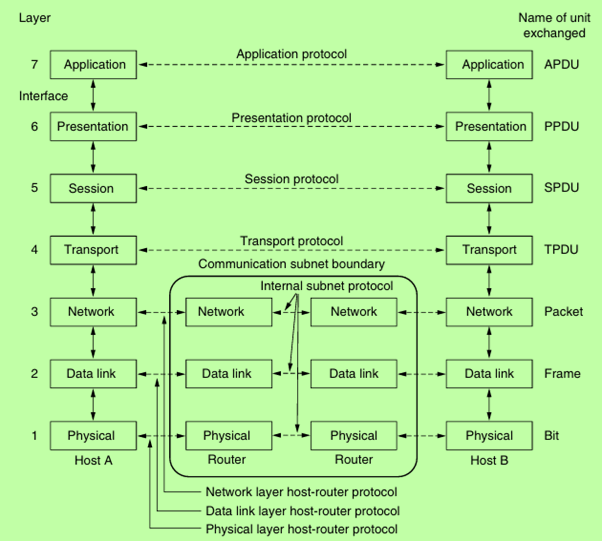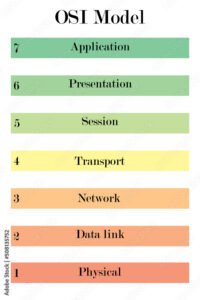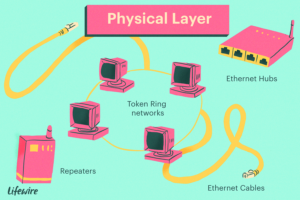OSI (Open Systems Interconnection) Reference Model
In this tutorial, we will explore the OSI (Open Systems Interconnection) Reference Model, a foundational framework for understanding network architectures. Although the protocols associated with the OSI model are not widely used today, the model itself remains relevant for understanding the principles of network communication. By breaking down the communication process into distinct layers, the OSI model provides a structured approach to designing and implementing network protocols.
1. Introduction to the OSI Reference Model
The OSI model was developed by the International Standards Organization (ISO) as a step toward standardizing the protocols used in various layers of network communication. The model consists of seven layers, each serving a distinct purpose in the communication process. This layered approach allows for modular design, where changes in one layer can occur without affecting the others, thus promoting flexibility and interoperability among different systems.
2. Principles of the OSI Model
The OSI model is based on several key principles that guide its structure and functionality:
→ Layer Abstraction: A layer should be created where a different abstraction is needed. This principle ensures that each layer can focus on a specific aspect of communication, allowing for specialization and efficiency.
→ Well-Defined Functions: Each layer should perform a well-defined function. This clarity of purpose helps in the design and implementation of protocols, making it easier to troubleshoot and maintain network systems.
→ International Standardization: The function of each layer should be chosen with an eye toward defining internationally standardized protocols. This promotes compatibility and interoperability among different systems and devices.
→ Minimized Information Flow: The layer boundaries should be chosen to minimize the information flow across the interfaces. This reduces complexity and potential errors in communication.
→ Appropriate Number of Layers: The number of layers should be large enough to separate distinct functions but small enough to avoid unwieldiness. This balance is crucial for maintaining an efficient and manageable network architecture.
3. Overview of the OSI Layers
The OSI model consists of seven layers, each with its own specific functions and responsibilities. Below, we will discuss each layer in detail, starting from the bottom layer and moving up to the application layer.
- Physical Layer
- Data Link Layer
- Network Layer
- Transport Layer
- Session Layer
- Presentation Layer
- Application Layer
1. Physical Layer
The physical layer is responsible for transmitting raw bits over a communication channel. It deals with the physical aspects of data transmission, including:
→ Signal Representation: Ensuring that when one side sends a 1 bit, it is received by the other side as a 1 bit, not as a 0 bit. This involves defining the electrical signals used to represent binary data.
→ Timing and Synchronization: Determining how long a bit lasts and ensuring that both sender and receiver are synchronized in their timing.
→ Connection Management: Establishing and tearing down connections when communication begins and ends.
→ Mechanical Interfaces: Specifying the physical characteristics of connectors, such as the number of pins and their functions.
These design issues largely deal with mechanical, electrical, and timing interfaces, as well as the physical transmission medium, which lies below the physical layer.
2. Data Link Layer
The data link layer transforms a raw transmission facility into a reliable line. Its main tasks include:
→ Error Detection and Correction: The data link layer masks transmission errors so that the network layer does not see them. It accomplishes this by breaking input data into data frames (typically a few hundred or a few thousand bytes) and transmitting the frames sequentially. If the service is reliable, the receiver confirms correct receipt of each frame by sending back an acknowledgment frame.
→ Flow Control: Managing the rate of data transmission between sender and receiver to prevent a fast transmitter from overwhelming a slow receiver. This is crucial for maintaining efficient communication.
→ Medium Access Control: In broadcast networks, the data link layer must also control access to the shared channel. A special sublayer of the data link layer, known as the medium access control (MAC) sublayer, deals with this problem, ensuring that multiple devices can communicate without interfering with each other.
3. Network Layer
The network layer controls the operation of the subnet. Key responsibilities include:
→ Routing: Determining how packets are routed from the source to the destination. This can involve static routing, where routes are predefined, or dynamic routing, where routes are adjusted based on current network conditions.
→ Congestion Control: Managing network congestion to prevent bottlenecks. The network layer works in conjunction with higher layers to adapt the load they place on the network, ensuring smooth data flow.
→ Interconnecting Heterogeneous networks: When packets need to travel from one network to another, the network layer addresses potential issues such as differing addressing schemes, packet size limitations, and protocol mismatches. It ensures that these challenges are overcome, allowing for seamless communication across diverse network environments.
4. Transport Layer
The transport layer is crucial for ensuring that data is delivered correctly and efficiently. Its functions include:
→ Data Segmentation: Accepting data from the upper layers and splitting it into smaller units, known as segments, which are then passed to the network layer for transmission.
→ Service Types: Providing various types of service to the session layer, including reliable, error-free delivery of messages in the order they were sent, as well as options for connectionless communication where message order is not guaranteed.
→ End-to-End Communication: Facilitating communication between programs on the source and destination machines. Unlike the lower layers, which focus on communication between immediate neighbors, the transport layer manages the entire end-to-end communication process.
5. Session Layer
The session layer plays a vital role in managing sessions between users on different machines. It provides services such as:
→ Dialog Control: Keeping track of whose turn it is to transmit data, ensuring orderly communication between parties.
→ Token Management: Preventing two parties from attempting the same critical operation simultaneously, which is essential for maintaining data integrity.
→ Synchronization: Implementing mechanisms for checkpointing long transmissions, allowing sessions to resume from the last checkpoint in the event of a crash or interruption.
6. Presentation Layer
The presentation layer focuses on the syntax and semantics of the transmitted information. Its responsibilities include:
→ Data Representation: Defining abstract data structures for communication, allowing systems with different internal representations to exchange information effectively.
→ Encoding Standards: Managing the encoding of data to ensure that it is correctly interpreted by the receiving system, regardless of its internal data format.
7. Application Layer
The application layer contains protocols that are commonly needed by users. Examples include:
→ HTTP (Hyper Text Transfer Protocol): The foundation of data communication on the World Wide Web, allowing browsers to request and receive web pages from servers.
→ File Transfer Protocol (FTP): Used for transferring files between computers over a network.
→ Simple Mail Transfer Protocol (SMTP): A protocol for sending and receiving email messages.
→ Network News Transfer Protocol (NNTP): Used for reading and posting articles to newsgroups.
Conclusion
The OSI Reference Model provides a comprehensive framework for understanding network communication. While the specific protocols associated with the OSI model may not be widely used today, the principles and functions defined at each layer remain crucial for designing and implementing effective network systems. By adhering to the OSI model, network engineers and developers can create interoperable systems that facilitate seamless communication across diverse platforms and technologies.
